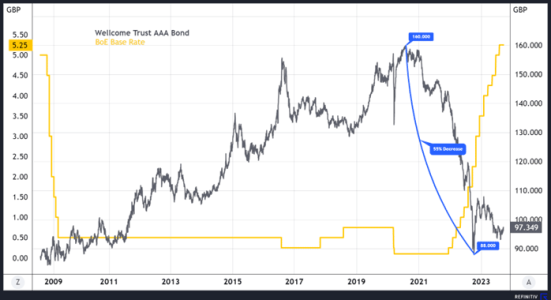Insights
How the bond markets are affecting your portfolio
This year marks my 25th year working in the financial services industry, helping clients make their money work for them. During that time there have been a number of market events including: The Dot Com Bubble in 1999, the Credit Crunch of 2007, the Euro Crisis in 2011, Brexit, the trade war between the USA & China during 2018 and of course the Covid pandemic starting in 2020. All of these have predominantly created equity market falls affecting your portfolio.
This time is different in that the equity markets have been volatile during the period of inflation and have stayed depressed for longer, not unlike the post Dot Com bubble downturn of 1999, which was punctuated by ‘9-11’ and the ensuing 2nd Gulf War.
Investors willingness to be exposed to the equity markets is normally assessed via an investment profiling tool. In our case, we use the well-regarded Oxford Risk Investment Compass to identify the most suitable investment profile for our clients to reduce the risks posed by being over exposed to higher risk investments. A typical balanced portfolio would be made up from 50% growth-based investments such as equities and 50% defensive investments such as fixed interest bonds and gilts. Most of us understand that the equity markets go down as well as up, but we would expect greater stability and less volatility from the defensive side of the investment portfolio.
This time the cause of investment volatility is partially down to the equity markets, however, we have also experienced much greater volatility in the defensive asset classes such as corporate bonds and gilts.
The table below shows the change in value of the AAA rated Wellcome Trust 4.625% 2036 corporate bond, which was first issued 25th July 2008, whilst we were still coping with the shocks of the credit crisis. We have used a single corporate bond in this example as it is easier to show the effect of interest rates when we look at one investment. Most investors would access fixed income investments via a fund called an open-ended investment company (OEIC), which contains many corporate bonds, offering diversification and may also be using some additional strategies to manage the fund. The orange line shows the changes in the Bank of England (BoE) base rate rapidly being reduced from 5.0% in late 2008 to 0.5% by early 2009 to protect the economy.
The sudden lowering of the BoE base rate caused the Wellcome trust AAA rated corporate bond to increase in value from £100 to £160, as pension funds and investors were keen to find low risk interest income paying investments, causing prices to bubble. Demand for high quality investment grade corporate bonds was spiked further by the UK Governments quantitative easing program buying these types of bonds.

This chart was produced by the William Highbourne Investment Committee using data from Refinitiv Workspace and is purely for illustrative purposes and should not be considered a recommendation.
What we are seeing now is the reversing of the interest rate reductions of 2008/2009 due to the need to curb inflation. With interest rates increasing from 0.1% to 5.25% it is therefore not unsurprising to see the value of high-quality corporate bond and gilts moving in the other direction. In the case of this particular bond the value fell by 45%. It is likely that many will be invested in this type of corporate bond through funds and many of the investment grade bond funds will have similar investments within them. To mitigate the effects of the change of interest rates the William Highbourne Investment Committee had focused on lower quality high yield bonds, which had not benefited from increases in values to the same extent, but continued to pay higher interest rates, so limiting the effect of rising interest rates on our portfolios.
What next?
Most commentators are speculating that we are closer to the top of the interest rate cycle than we are to the bottom, and although there may be some more rate rises to come, we are already seeing mortgage rates and longer-term fixed term deposit rates starting to come down. The BoE Monetary Policy Committee has held interest rates for the first time at its last meeting, though markets are indicating another small rise this autumn.
This means that we must start considering what interest rates will be in 12 months and two years’ time. What will the effect be on the values for high quality bonds such as the Wellcome 4.625% 2036 be as interest rates fall by 1% or 2%, bearing in mind that the government’s inflation target is 2% per year.
For those who are already invested it is important to review your portfolio to make sure that you have the correct asset allocation for the next phase. Over the last few years, we have been expecting that rates would rise, and we have turned clients away from portfolios with high levels of defensive assets such as corporate bonds and gilts. Now, we are far more comfortable investing in lower risk investment portfolios containing higher levels of fixed interest assets following improvements in the yields to maturity offered by corporate bonds and gilts.
Some investors with new money to invest may be tempted by high-rate fixed term cash deposits in bank accounts. These do and should form an important part of many people’s emergency funds, but those that are tied up too long are not accessible in an emergency, nor will they benefit from the potential upswing in investment values as interest rates come down. We have already started to see some of the higher term deposit rates on our Insignis Cash Platform fall from 6.2% for 1 and 2 years termed deposits a few weeks ago to 6.0% and 6.05% respectively with further lowering of rates expected. Investors looking for fixed interest investments should speak with their wealth manager as our Insignis cash hub (minimum deposit £100,000, for further information visit our website) provides access to over 40 financial institutions and a wide range of accounts including easy access accounts, 1, 3, 6 and 9-month term deposits and 1 to 5 year fixed term accounts and all with a single account opening process.
We are also acutely aware that as interest rates fall, this will potentially reverse the effect on bond prices, leading to a recovery in the market, increasing the value of fixed income investments like corporate bonds, which for new and current investors could be very attractive when combined with the income they produce. This will be the first time that we have seen this in over a decade.
Looking back at the chart, you can see that the value of the Wellcome Trust AAA bond started to fall nearly 12 months before the first rate rises. This is because the city looks forward and tries to anticipate what is going to happen next. Unlike the sea which calms as it reaches low tide, the turning point in the markets can still have a sting in its tail before it moves forward in a different direction. However, perhaps the time is approaching to consider Warren Buffet’s famous words: ‘’be fearful when others are greedy and be greedy when others are fearful.’’
Please contact your wealth manager if this article raises any concerns or interest in discussing how to invest or to access our Insignis cash solution for your longer term financial goals.
Pieter Burger FCSI FPFS
Principal and Chartered Wealth Manager
Legal information
Opinions constitute our judgment as of this date and are subject to change without warning. The value of investments, and the income from them, can go down as well as up; you may not recover the amount of your original investment.
When an investment involves exposure to a foreign currency, changes in rates of exchange may cause the value of the investment, and the income from it, to go up and down.
Past performance is not a reliable indicator of future results and forecasts are not a reliable indicator of future performance. Interested parties should seek advice from their wealth manager.
Tax treatment depends on an investor’s individual circumstances, and it may be subject to change.

